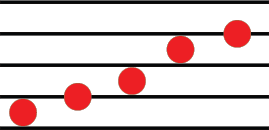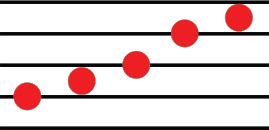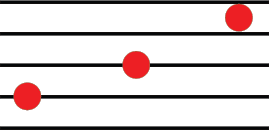Y2. Lesson 18. Practising the major pentatonic scale
Prior learning: Major pentatonic scale
Duration: 30 minutes
Materials:
Keywords: Beat, rhythm, singing, chanting, partners, rhymes, circle games.
Difficulty: ![]()
Prepare
Present
Practise
Major pentatonic scale
 Melodic development
Melodic development
![]() Students discover the pentatonic scale in a known song.
Students discover the pentatonic scale in a known song.
- Project the score on the board.
- Lead the class in singing Pumpkin and sequentially point to the notes on the board as you do so.
- When secure, ask the class what is the lowest note in the song. [do]
- Ask what the highest note is. [la]
- Sing again and use hand signs.
- Ask the class how many different hand signs did they see. [5]
- Sing again using solfa and ask the class to repeat after you.
- Teach that these five notes make up the pentatonic scale.
 Rhythmic development
Rhythmic development
![]() Students learn how rhythms are played on a Ghanan log drum.
Students learn how rhythms are played on a Ghanan log drum.
- Distribute untuned percussion instruments to the class.
- Play the short video of the musician explaining how sounds are made on a log drum.
- When finished, ask students what they discovered.
- Discuss what the drum was made from [log] and why there are parts that are hollow [to make the sound]. What material was used at the end of the drumstick? [rubber]
- Project the rhythm pattern graphic.
- The graphic is for illustrative purposes only; any suitable unturned percussion instruments may be used.
- Divide the class into three groups and show each group the pattern they will play on their instrument.
- Begin with the group who will play crotchets.
- When secure, add the ti-ti ta rhythm from the second group.
- Finally, add the quaver rhythm from the third group.
 Creative movement
Creative movement
![]() Students sing and dance to this classic classroom song.
Students sing and dance to this classic classroom song.
- Students form a circle, with one or more individuals positioned within the circle's centre.
- The circular formation moves and sings the initial two lines of the verse.
- Following this, they come to a halt, allowing the player or players at the centre to each select a partner who joins them inside the circle.
- Holding hands, the newly formed pairs dance around to sing the concluding two lines of the verse.
- The last lines are 'Yes I know the Muffin Man, the Muffin Man, the Muffin Man' x 2
 Questions
Questions
- What does the Muffin Man sell?
- Where does he live?
- Have you ever met the Muffin Man?
 Listening
Listening
![]() Students listen and respond to solfa pitch patterns.
Students listen and respond to solfa pitch patterns.
- Students are seated and attentive.
- Begin by singing the major pentatonic and using hand signs.
- Play the first track from the audio player and ask students to sing the second time you play it.
- Ask students what the solfa pattern is.
- Ask them to use hand signs.
- Repeat with each of the subsequent tracks, which are in ascending order of difficulty.
 Visual learning
Visual learning
![]() Students write the major pentatonic scale starting on lines and spaces.
Students write the major pentatonic scale starting on lines and spaces.
- Project the first score of the major pentatonic starting on a line. [in G]
- Lead students in singing the scale.
- When secure, ask the class to write the first scale in their notebooks, including the solfa. Draw attention to the fact that it starts on a line.
- Remind students that the pattern starting from do is step, step, skip, step.
- Teach that do can also sit in a space.
- Ask students to draw the second scale in their notebooks, starting with do in a space.
 Instruments
Instruments
![]() Students discover how to play the first eight bars of a known classroom song.
Students discover how to play the first eight bars of a known classroom song.
- Distribute tuned percussion instruments. In this exercise, xylophones are chosen.
- Divide the class into two groups.
- Demonstrate the melody of the first eight bars of the song to the first group.
- When secure, demonstrate the simple accompaniment to the second group.
- Conduct the two groups and monitor the class performance, offering gentle guidance where appropriate.
- The song's second half is shown in the next lesson [19].

 Part work
Part work
![]() Students sing Apple Tree and clap an ostinato pattern.
Students sing Apple Tree and clap an ostinato pattern.
- Students are seated and attentive.
- Explain that the class will sing Apple Tree and clap an ostinato pattern.
- Begin by clapping the ostinato pattern (an example is shown below).
- Lead the class in singing and clapping the ostinato.
- Monitor for tuneful and accurate singing as well as correct ostinato clapping.

Students section

Try these quick questions!



 Assess
Assess
Suggested lessons
Y1. Beat II

Y1. Beat III

Y1. Beat IV

